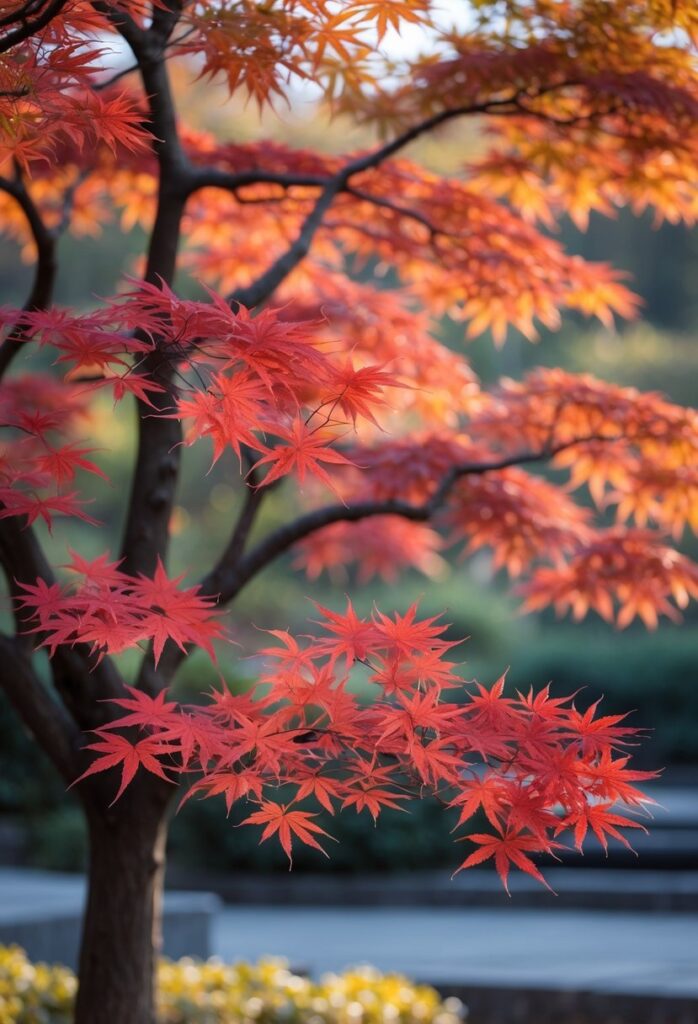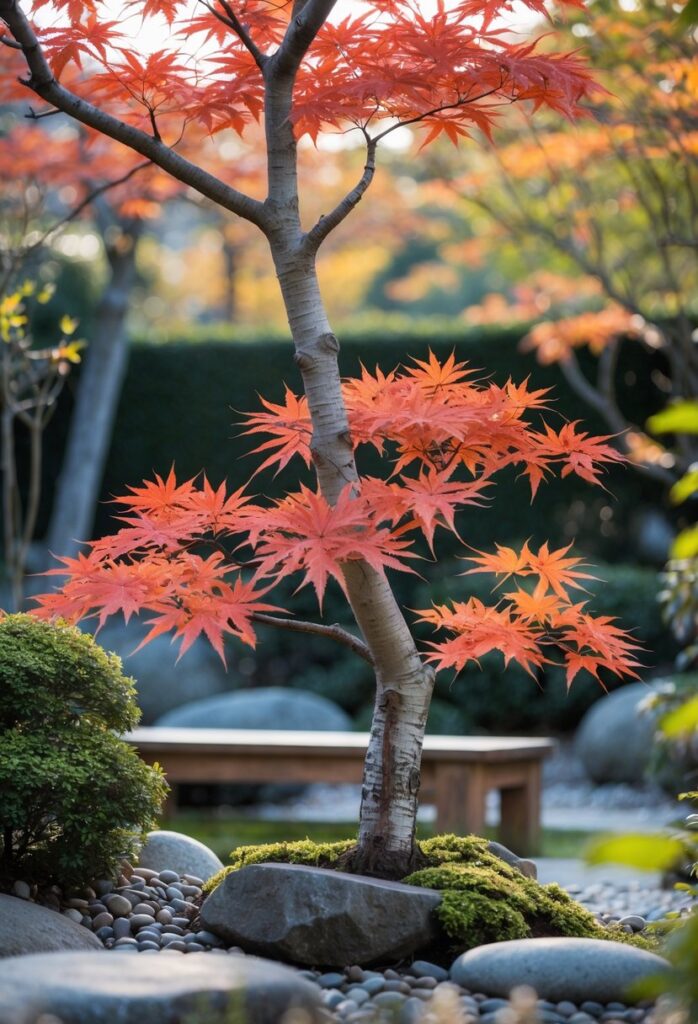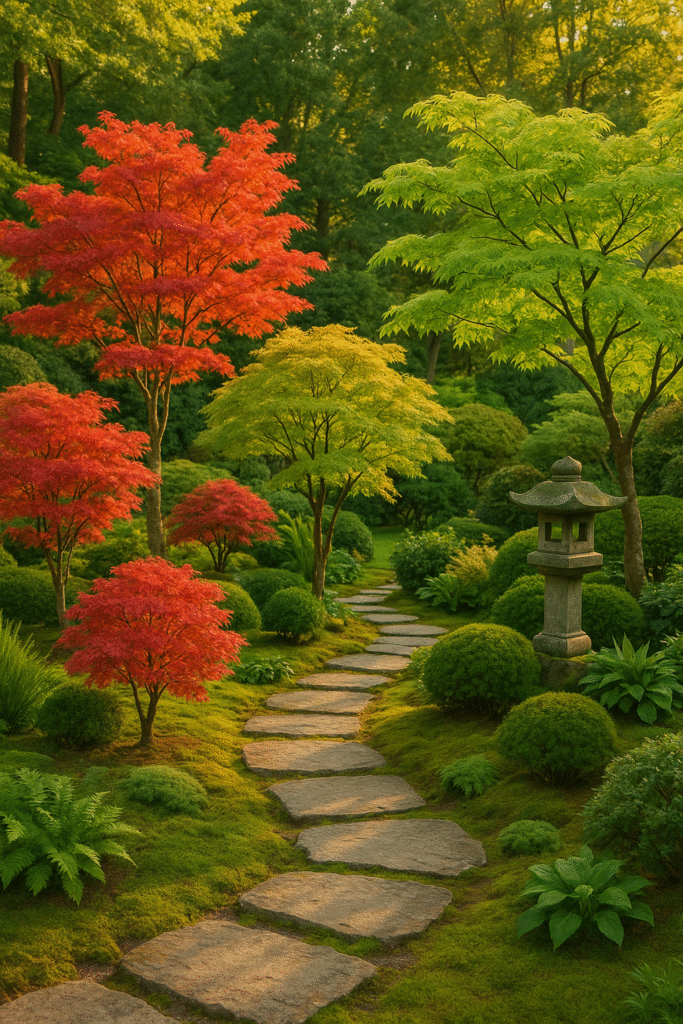Japanese Maple Tree: Complete Guide for Growing and Care
Japanese maple trees are popular for their striking colors and graceful shapes, making them a favorite in many gardens. They come in many varieties, each with unique leaf shapes, colors, and sizes, which means there is a perfect type for almost any garden space. They are valued for being both beautiful and adaptable, thriving in different light conditions and garden settings.

Caring for a Japanese maple is not difficult if planted in the right location and given proper attention. These trees can grow well in containers or garden beds, and with the right care, they offer vibrant foliage year-round. Understanding their needs for water, soil, and protection from harsh conditions helps keep the tree healthy and looking its best.
Many gardeners appreciate that Japanese maples can be shaped through pruning to fit specific designs or kept natural for a softer look. Their slow growth also means they fit well in smaller spaces and can last for many years, adding elegance over time.
Key Takeaways
- Japanese maples come in many varieties suitable for different garden spaces.
- Proper planting and regular care are essential for healthy growth.
- Pruning helps maintain the tree’s desired shape and size.
Understanding Japanese Maple Tree Varieties

Japanese maples offer a wide range of forms, sizes, and colors. Some are upright trees, while others have a weeping habit. Leaf shapes and colors vary greatly, and some varieties hold their color all summer, while others change with the seasons.
This diversity allows gardeners to find a type that fits many garden styles and climates. Below are key groups and notable examples of Japanese maples to know.
Acer palmatum and Species Overview
Acer palmatum is the most common species of Japanese maple. It is known for its palmate leaves, which look like hands with five to nine lobes. These trees are usually medium-sized and have a graceful shape.
Other species include Acer shirasawanum and Acer japonicum. These differ slightly in leaf shape, color, and growth habits. Most Japanese maples come from these species or their hybrids.
The leaves can be green, red, yellow, or variegated, depending on the variety. They often provide strong fall colors, making them popular in landscaping. Acer palmatum is prized for its adaptability and delicate foliage.
Popular Varieties: Bloodgood, Crimson Queen, Red Dragon
Some Japanese maple varieties are well-known for their distinct colors and shapes.
- Bloodgood is famous for its deep red leaves that keep their color through summer into fall. It grows about 15-20 feet tall with an upright habit.
- Crimson Queen is a weeping type with finely divided, deep red leaves. It is smaller, usually under 10 feet, and adds a dramatic look.
- Red Dragon is similar to Crimson Queen but has even more deeply cut leaves and a striking, dark red hue.
These varieties are widely available and suited for a variety of garden spaces. Their strong colors make them excellent focal points.
Dwarf Japanese Maple and Unique Cultivars
Dwarf Japanese maples are small trees or shrubs that fit well in compact gardens or containers. They usually grow under five feet tall.
Examples include ‘Coonara Pygmy’, which stays very small with dense, bright green leaves. It offers a sculptural form and fine texture.
Dwarf maples are ideal for small spaces or bonsai. They require less pruning but still show seasonal color changes, ranging from green to vibrant reds or yellows.
Unique cultivars offer interesting leaf shapes, colors, and growth habits that stand apart from common varieties.
Rare and Noteworthy Types: Autumn Moon, Villa Taranto, Coonara Pygmy
Some Japanese maples stand out for their rarity, color, or growth form.
- Autumn Moon has bright yellow to lime-green leaves in summer that turn a strong orange and red in fall. It grows around 15-18 feet with a rounded shape.
- Villa Taranto features deeply lobed pink-red leaves that provide a softer color than the typical reds. It is an upright tree.
- Coonara Pygmy is a rare dwarf maple that remains under 3 feet tall. It is valued for its compact form and subtle leaf coloring.
These types are less common but prized by collectors and gardeners wanting something unique. They often require more care or specific growing conditions. For more details on types, visit a guide to different Japanese maple types.
Choosing the Right Japanese Maple for Your Garden

Choosing a Japanese maple involves looking closely at its size, shape, leaf color, and how well it adapts to your climate. These factors help ensure the tree fits in your space and garden style while thriving throughout the seasons.
Selecting by Size, Form, and Growth Habit
Japanese maples (Acer palmatum) vary widely in size, from small dwarf varieties growing 2-4 feet tall to larger forms reaching 20-30 feet. Knowing how much space is available helps narrow choices.
Growth habits also differ. Some have weeping or cascading branches, perfect for focal points or containers. Others grow upright or rounded, fitting well in groves or mixed borders. Dwarf Japanese maples work well for small gardens or as patio plants.
Choosing the right form depends on use. For example:
- Upright trees for screens or shade
- Cascading or weeping for visual drama
- Compact types for container planting
Picking Foliage Color and Leaf Shape
Japanese maples offer a variety of leaf colors that change by season. Common hues include red, green, orange, purple, and even variegated patterns. Some start red in spring and shift to green by summer, then turn yellow or orange in fall.
Leaf shape falls mainly into two types:
- Palm-shaped with broader lobes
- Delicate, lacy dissected leaves that look finer and softer
The choice often matches garden style. Larger, bold leaves suit formal settings, while lacy leaves add a delicate, natural touch.
USDA Zones and Climate Considerations
Most Japanese maples thrive in USDA zones 5 to 8. In colder Zone 4, few survive outdoors except very hardy cultivars or related species like Korean maples, which tolerate cold better.
Protection from harsh afternoon sun and drought is important in warmer zones to prevent leaf scorch. Regular watering during summer helps.
In cold areas, growing Japanese maples in containers allows moving them indoors over winter. Proper shelter aids survival for several years. Understanding your zone and local climate is key to selecting a variety that lives long and looks healthy.
Learn more about selecting varieties based on size and climate at How to Select the Right Japanese Maple for Your Garden.
Planting Japanese Maple Trees

Japanese maple trees need careful site selection and proper planting methods to grow well. Choosing the right soil, light, and planting techniques ensures the tree develops healthy roots and vibrant foliage.
Ideal Site Selection and Soil Requirements
Japanese maples thrive in well-drained soil with moderate moisture. The soil should be sandy loam or amended with organic matter if heavy clay or dense soil is present. Poor drainage causes root rot, so the planting site must not be soggy.
The soil pH should range from 5.5 to 6.5, slightly acidic to moderately acidic. Testing soil drainage by digging a hole and timing water drainage helps determine if the site is suitable.
These trees perform best with morning sun and afternoon shade, especially in hot climates. A spot with dappled or filtered light mimics their natural woodland edge environment. Full afternoon sun may burn delicate leaves unless the variety is sun-tolerant.
When and How to Plant
The best time to plant Acer palmatum is spring or fall when temperatures are mild. The planting hole should be three times wider than the root ball but only as deep as the root ball’s height.
If the soil drains slowly, plant the tree higher on a mound to avoid root sogginess. In well-drained soils, plant the root ball so its top is about 3 to 4 inches above ground. Backfill soil gently, removing air pockets and watering deeply after planting.
Mulching with 1 to 2 inches of aged wood chips or pine straw conserves moisture and suppresses weeds. Avoid piling mulch against the trunk. Staking young or tall trees provides extra support but should be done carefully to avoid bark damage.
Container and Bonsai Planting Tips
Japanese maples grow well in containers, which is ideal for dwarf Japanese maple varieties or bonsai forms. Use a high-quality, well-draining potting mix with organic matter.
Containers should have drainage holes to prevent waterlogging. Frequent watering is necessary since pots dry out faster than ground soil. Water deeply but allow the soil surface to dry slightly between waterings.
For bonsai, pruning roots and leaves keeps the tree small and shaped. Repotting every 2-3 years refreshes soil and prevents roots from becoming pot-bound. Regular feeding with diluted fertilizer supports growth in container settings.
Using containers lets gardeners move Japanese maples to protect them from harsh weather or intense sun. It also allows control over soil quality, drainage, and moisture levels more easily than in-ground planting.
For full planting details, see the step-by-step guide to planting Japanese maple trees.
Caring for Japanese Maples Year-Round

Japanese maples need different care depending on the season. Proper watering, pruning, and protection from the weather help keep the tree healthy and vibrant. Paying attention to seasonal needs avoids common problems like leaf scorch or root rot.
Spring and Summer Maintenance
In spring, inspect the Japanese maple for broken or weak branches and prune lightly before the leaves fully grow. For varieties like Crimson Queen and Red Dragon, use sharp, clean tools to avoid harming the tree.
Water the tree only when the soil feels dry about 3 inches down. Deep watering works best, especially for newly planted maples. Avoid overwatering, which can cause root problems.
During summer heat, provide afternoon shade, as strong sun can scorch leaves. Move container-grown trees like Autumn Moon to cooler spots when necessary.
Check weekly for pests such as aphids or scale insects. Use natural insecticides like neem oil to control infestations without harming the tree.
Fall and Winter Care
In fall, rake fallen leaves to prevent fungus and apply a 2-3 inch mulch layer at the tree’s base. Give the tree a deep watering before the first frost to protect roots through winter.
Do not fertilize in fall, as this can encourage new growth that won’t survive cold temperatures. For young or vulnerable maples, wrapping the trunk with burlap helps protect from harsh winter winds.
In winter, keep mulch in place around the roots for insulation. For potted Japanese maples, move them indoors or insulate pots to prevent freezing. Late winter is a good time to prune for structure while the tree is dormant and leafless.
Find more detailed care tips for Japanese maples like Crimson Queen and Autumn Moon at Japanese maple tree care guides.
Pruning and Shaping Japanese Maple Trees

Pruning Japanese maple trees requires precise timing and techniques to support strong growth and maintain their natural beauty. It is important to remove unwanted branches carefully and choose the right moments in the year for trimming. Proper shaping encourages healthy air flow and light penetration, which benefits overall tree health.
Best Times and Techniques for Pruning
The ideal time to prune a Japanese maple tree is in late winter or early spring before new growth begins. This timing reduces stress on the tree and allows cuts to heal quickly. Avoid heavy pruning in fall, as slow healing during cold months can cause damage.
When pruning, remove no more than 20-30% of the canopy to prevent weakening the tree. Focus on cutting inward-facing, intersecting, or rubbing branches. This improves airflow and keeps the tree balanced. Use sharp, clean tools like pruning shears or loppers to make precise cuts. Avoid hedge trimmers, which can harm the delicate branches of the Japanese maple.
Maintaining Health and Desired Form
Maintaining a Japanese maple’s health means regularly thinning crowded areas and removing dead or damaged wood. This prevents disease and supports vibrant foliage. For shaping, keep a single dominant leader and prune competing leaders to ensure a strong structure.
Different cultivars, like weeping or upright maples, require specific shaping approaches. For example, pruning weeping maples enhances their graceful, cascading form without encouraging too much new growth. Meanwhile, thinning the center of vase-shaped maples supports light penetration.
Regular selective pruning over several seasons shapes the tree while minimizing stress. It is important to visualize the tree’s form before making cuts and focus on preserving its natural architecture.
Common Problems and Solutions

Japanese maple trees can face several challenges that affect their health and appearance. These often include pests, diseases, water issues, and environmental factors. Knowing how to spot and treat these problems early helps keep the tree strong and beautiful.
Pest and Disease Management
Japanese maples are vulnerable to pests like aphids, scale insects, mites, and beetles. These pests cause leaf curling, discoloration, and weakened growth by sucking sap or damaging tissues. Regular inspection helps catch infestations early.
Using horticultural oils or insecticidal soaps can control many pests. Introducing natural predators, such as ladybugs, also aids in pest control. In severe cases, consulting an arborist is advisable.
Common diseases include verticillium wilt, root rot, anthracnose, and leaf spots. These can cause wilting, leaf drop, and stem dieback. Prevent disease by avoiding injuries to the tree, ensuring good air circulation, and watering correctly.
If disease is suspected, professional diagnosis and treatment are needed. Removing infected leaves and using appropriate fungicides may help control fungal problems. Proper care reduces the risk of both pests and diseases for the Japanese maple tree.
Preventing Leaf Scorch and Root Rot
Leaf scorch appears as brown, dry patches on leaves, mainly caused by too much sun, hot winds, or uneven watering. Japanese maples prefer morning sun with shade during hot afternoons to avoid scorch.
Consistent, deep watering keeps soil evenly moist but not soggy. Overwatering can cause root rot, which weakens the tree and leads to leaf browning or falling leaves.
Mulching around the base helps retain moisture and regulate soil temperature. It also prevents sudden dryness that can stress roots. Using a well-draining soil mix is crucial to avoid waterlogging.
Reducing fertilizer use, especially nitrogen-heavy types, helps prevent salt buildup that can worsen scorch or root issues. Applying balanced fertilizer according to instructions supports the tree’s health without overfeeding.
Dealing with Environmental Stress
Environmental stress can cause slow growth, leaf discoloration, or branch dieback in Japanese maples. Factors include extreme temperatures, poor soil conditions, and exposure to strong winds.
Planting in sheltered locations reduces wind damage and heat stress. Japanese maples thrive in slightly acidic, well-drained soil with moderate nutrient levels.
Soil testing can identify pH or nutrient imbalances affecting leaf color or growth rate. Aerating compacted soil improves root access to oxygen and water.
Regular pruning of dead branches and maintaining proper spacing improves airflow and sunlight penetration. Preventing physical damage from animals or weather also reduces stress.
Taking these steps helps Japanese maples adapt better, promoting steady growth and vibrant foliage.
For more detailed guidance, see information on Japanese maple problems and solutions.
Frequently Asked Questions

Japanese maples need different care depending on the season. They face common pests like aphids and spider mites. Growth speed varies by variety and environment. Soil acidity and drainage are important. Pruning done at the right time helps health and shape.
How do I care for a Japanese maple tree in different seasons?
In spring, water regularly and fertilize with a slow-release fertilizer.
During summer, keep soil moist but avoid waterlogging.
In fall, reduce watering and prepare for leaf drop.
Winter care involves protecting the tree from harsh winds and frost, especially young trees.
What are the common pests and diseases that affect Japanese maple trees?
Aphids and spider mites are frequent pests. They cause leaf damage and weaken the tree.
Powdery mildew and root rot can also occur if conditions are too wet or poorly drained.
Regular inspection and organic insecticides help control pests early.
How fast do Japanese maple trees grow, and what factors influence their growth rate?
Growth is usually slow to moderate, about 1 foot per year.
Factors like soil quality, watering practices, sunlight, and climate affect growth.
Trees in USDA zones 5-8 with ideal soil and care grow best.
What are the key differences between standard and dwarf Japanese maple varieties?
Standard varieties grow taller, often 15 to 25 feet or more.
Dwarf varieties stay compact, usually under 6 feet tall, making them suitable for small gardens or containers.
Size and shape impact placement and care needs.
What are the ideal soil conditions and pH levels for planting a Japanese maple?
Japanese maples prefer well-draining soil with a pH between 5.5 and 6.5.
Soil should be slightly acidic and rich in organic matter for best results.
Avoid heavy clay or compacted soil unless amended for better drainage.
How and when should Japanese maple trees be pruned for optimal health and shape?
Prune in late winter or early spring before new growth starts.
Remove dead or crossing branches to improve air flow.
Use sharp, clean tools and avoid cutting more than 20% at once.
Cut at a 45-degree angle above buds to encourage healthy regrowth.
